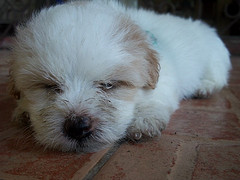It’s flu season, and not just for humans! According to the Center for Disease and Control (CDC), Canine Influenza Virus (H3N8) or “Dog Flu” is a contagious respiratory disease that is easily transmitted through our dogs. Because Canine Influenza Virus is a relatively new virus, most dogs have not been exposed to it before.
A small percentage of dogs can experience very serious complications such as pneumonia, just like the humans infected with influenza.
Dr. Jeff Werber is an Emmy Awarding winning veterinarian and cares for the pets of some of Hollywood’s biggest stars. He answered our questions about the Dog Flu and if you should be worried.
What is Dog Flu?
Dog flu or Canine Influenza is a contagious respiratory disease in dogs caused by a specific Type A influenza virus (H3N8). The “canine influenza virus” was originally an equine (horse) influenza virus that spread to dogs in 2004 and can now spread between dogs.
It is similar to the swine flu that affects humans. It’s not a new flu, but has been around for about 10 years.
Is there a risk to humans?
To date, there is no evidence of transmission of canine influenza virus from dogs to humans. However, the CDC explains that influenza viruses are “constantly changing and it is possible for a virus to change so that it could infect humans and spread easily between humans. Such a virus could represent a pandemic influenza threat. For this reason, CDC and its partners are monitoring the H3N8 influenza virus (as well as other animal influenza viruses) very closely. In general, however, canine influenza viruses are considered to pose a low threat to humans.” As mentioned earlier, while these viruses are well established in horse and dog populations, there is no evidence of infection among humans with this virus.”
How high is the risk to dogs?
There have been outbreaks of “canine flu” since 2004. One of the vaccine companies offered free influenza testing to veterinarians. I must have sent in 25-30 swabs to be checked and had no positive results. Most respiratory cases are going to be para influenza or other bacterial infections but not the influenza virus, the “canine flu.”
How is it Spread?
Canine influenza virus can be spread to other dogs by direct contact with aerosolized respiratory secretions (sputum and saliva) from infected dogs, by uninfected dogs coming into contact with contaminated objects, and by moving contaminated objects or materials between infected and uninfected dogs. Therefore, dog owners whose dogs are coughing or showing other signs of respiratory disease should not expose other dogs to the virus. Clothing, equipment, surfaces, and hands should be cleaned and disinfected after exposure to dogs showing signs of respiratory disease. Some dogs are asymptomatic (show no signs of the disease) so it may difficult to take precautions.
It does seem to attack where dogs are either housed together like in boarding/kennel situation, or congregate, such as a dog park.
Is there a vaccine?
There is available a canine influenza virus vaccine, Nobivac® Canine Flu H3N8, but it does not prevent the virus, rather it minimizes the severity of its impact and its spread. There are few side effects reported.

What is the treatment?
About 80% of the dogs with the flu will have a mild form of the disease characterized by cough, nasal discharge and fever that will resolve over time with appropriate therapy. A small proportion of dogs can develop severe disease. These dogs experience complications such as pneumonia, just like the humans infected with influenza.
If contracted, there is no specific anti-viral medication; the dog is treated with supportive care which often includes antibiotics to treat secondary bacterial infections. High quality nutrition and a stress free environment is also recommended. Treatment largely consists of supportive care. This helps the dog mount an immune response. In the milder form of the disease, this care may include medication to make your dog more comfortable and fluids to ensure that your dog remains well-hydrated.
The goal is to support the body to maximize its effectiveness in fighting the virus.
Symptoms
If your dog exhibits respiratory symptoms, coughing, runny nose, fever, lethargy, see your veterinarian. Most likely, your dog just has a regular cold or maybe Kennel Cough. Even so, they will feel better quicker with a vet’s help.
About the Author
Based in Wilsonville, Ore., animal lover Kristina N. Lotz is a Certified Professional Dog Trainer – Knowledge Assessed (CPDT-KA) and works as a full time trainer. She is the founder of A Fairytail House, a unique all-positive all-sport dog training facility that helps rescue dogs in her area and provides free seminars and training classes for the community. In her spare time, she trains and competes in herding, agility, obedience, rally, and conformation with her Shetland Sheepdogs. She smartly married a Veterinary Technician, who helps keep the fur kids happy and healthy, and provides a quick resource for articles.

